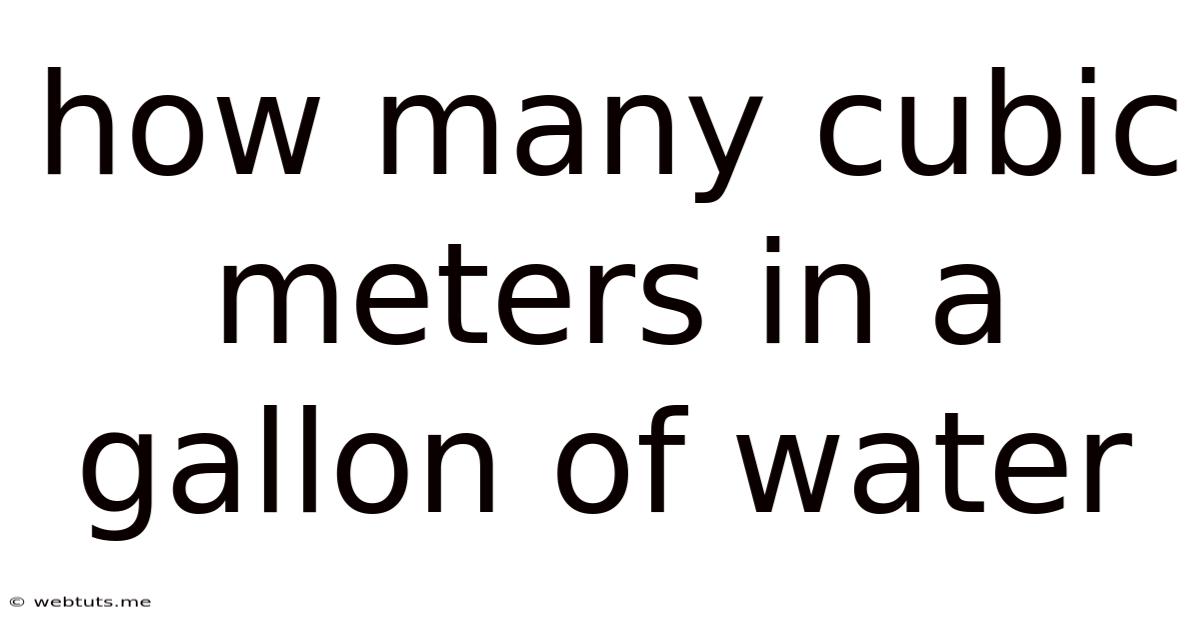How Many Cubic Meters In A Gallon Of Water
Webtuts
May 12, 2025 · 4 min read

Table of Contents
How Many Cubic Meters in a Gallon of Water? A Comprehensive Guide
Understanding unit conversions is crucial in various fields, from engineering and construction to everyday household tasks. One common conversion that often causes confusion is determining the equivalent volume of a gallon of water in cubic meters. This comprehensive guide will delve into the specifics of this conversion, exploring the underlying principles and providing practical examples to solidify your understanding. We'll also examine related concepts and address common misconceptions.
Understanding Units of Volume
Before we dive into the conversion, let's establish a clear understanding of the units involved:
-
Gallon (gal): A unit of volume commonly used in the United States and some other countries. There are different types of gallons (US liquid gallon, US dry gallon, imperial gallon), leading to slight variations in volume. For our purposes, we'll primarily focus on the US liquid gallon, which is the most commonly used type.
-
Cubic Meter (m³): A unit of volume in the metric system. It represents the volume of a cube with sides of 1 meter each. This is the standard unit of volume in scientific and engineering contexts.
The Conversion Factor: Gallons to Cubic Meters
The core of the conversion lies in the precise relationship between gallons and cubic meters. The conversion factor is approximately 0.00378541 cubic meters per US liquid gallon. This means that one US liquid gallon is equal to 0.00378541 cubic meters. It's crucial to remember that this is an approximation; the actual value might vary slightly depending on the precision of the measurement standards used.
Calculating Cubic Meters from Gallons
The conversion formula is straightforward:
Cubic Meters = Gallons × 0.00378541
Let's illustrate this with some examples:
-
Example 1: Convert 5 gallons to cubic meters.
Cubic Meters = 5 gallons × 0.00378541 m³/gal ≈ 0.0189 m³
-
Example 2: Convert 100 gallons to cubic meters.
Cubic Meters = 100 gallons × 0.00378541 m³/gal ≈ 0.379 m³
-
Example 3: Convert 1000 gallons to cubic meters.
Cubic Meters = 1000 gallons × 0.00378541 m³/gal ≈ 3.79 m³
These examples clearly show the application of the conversion factor. Remember to always use the appropriate conversion factor based on the type of gallon being used (US liquid gallon in this case).
Practical Applications and Real-World Scenarios
Understanding this conversion is useful in a variety of situations:
-
Aquaculture: Calculating the volume of water in fish tanks or aquaculture ponds.
-
Irrigation: Determining the amount of water needed for irrigation purposes in agriculture.
-
Construction: Calculating the volume of concrete, water, or other liquids used in building projects.
-
Environmental Science: Measuring water flow rates in rivers and streams.
-
Swimming Pools: Calculating the water volume of a swimming pool for chemical treatments.
Beyond Simple Conversions: Dealing with Irregular Shapes
While the conversion is straightforward for regular shapes, calculating the volume of irregularly shaped containers or natural water bodies requires additional steps:
-
Approximation: For irregularly shaped containers, approximate the volume by dividing it into smaller, more manageable shapes (cubes, cylinders, etc.) and summing their volumes.
-
Water Displacement: A common method for measuring irregular volumes is the water displacement method. Fill a container with a known volume of water. Submerge the object, and measure the increase in water level. The difference represents the volume of the object. This method can then be converted to cubic meters using the gallon-to-cubic-meter conversion factor.
-
3D Scanning: Modern technology employs 3D scanning to create precise digital models of objects, allowing for accurate volume calculations, which can then be converted to cubic meters using the gallon-to-cubic-meter conversion factor.
Common Mistakes and Misconceptions
-
Using the Wrong Conversion Factor: The most common mistake is using the wrong conversion factor. Always ensure you're using the correct conversion factor for the specific type of gallon (US liquid gallon).
-
Unit Inconsistency: Pay close attention to units. Mixing imperial and metric units can lead to significant errors. Stick consistently to either imperial or metric units throughout your calculations.
-
Ignoring Significant Figures: Remember to consider significant figures when reporting your results to maintain accuracy and avoid misleading precision.
Expanding Your Knowledge: Related Conversions
Understanding the gallon-to-cubic-meter conversion opens doors to other important conversions:
-
Gallons to Liters: One US liquid gallon is approximately equal to 3.78541 liters.
-
Cubic Meters to Liters: One cubic meter is equal to 1000 liters.
-
Gallons to Cubic Feet: One US liquid gallon is approximately equal to 0.133681 cubic feet.
Mastering these conversions allows for a seamless transition between different unit systems, crucial for efficient problem-solving in various fields.
Conclusion: Mastering the Conversion for Practical Applications
Converting gallons to cubic meters is a fundamental skill with far-reaching implications across multiple disciplines. By understanding the conversion factor, practicing the calculation, and being mindful of potential pitfalls, you can confidently tackle various volume-related problems. Remember the importance of accuracy, consistency in units, and the consideration of significant figures to ensure your results are reliable and meaningful. This knowledge empowers you to confidently handle volume-related calculations in your professional and personal life, making you more efficient and precise in your work. From simple household tasks to complex engineering projects, the ability to convert gallons to cubic meters is an invaluable asset.
Latest Posts
Related Post
Thank you for visiting our website which covers about How Many Cubic Meters In A Gallon Of Water . We hope the information provided has been useful to you. Feel free to contact us if you have any questions or need further assistance. See you next time and don't miss to bookmark.